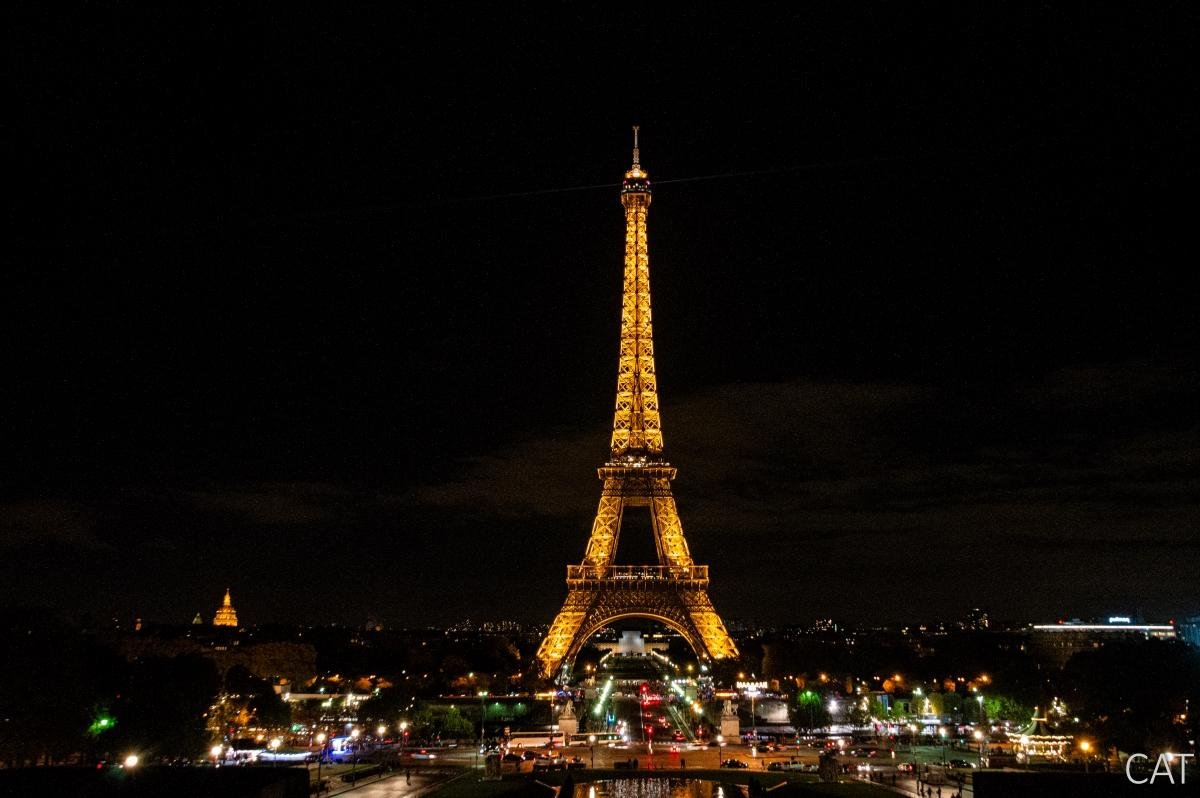Cooking up Amazing Trips contains affiliate links. If you purchase through these links, I may earn a commission at no extra cost to you. See my Disclosure Policy for more information. Thanks for supporting my blog!
Paris in 3 – 4 days
Are you going on a getaway to Paris and need an itinerary to see the city in 3 – 4 days? Don’t worry—this is my speciality: getting you to visit the most important attractions in a limited time.
Paris is a massive city with many attractions, so it can be overwhelming to decide what to see, mainly if you have limited time. If, like me, you don’t have a whole week to explore all its attractions, this article is perfect for you.
As always, I will first provide some interesting information about the city and then detail the itinerary (with a map) to see the most significant things about Paris in 3–4 days.
This is the list of everything you will find in this article:
A. Paris – Information of Interest

Location


Paris is located in the north of France, in the region called ‘Île-de-France’, on the banks of the Seine River.
It is the country’s capital and is consistently ranked as the most visited city in the world every year.
Area
City area: 105 square kilometres (41 square miles);
Metropolitan area: 2,300 square kilometres (890 square miles).
Population

In 2023, Paris had 2.2 million inhabitants and 11 million in the metropolitan area, making it the most populated city on the European continent.
Demonym
Parisian.
Language

Paris, the capital of France, has French as the primary language spoken.
Remember that you can check the language spoken in each country using the tables that I attach to my articles Countries by Language and Best Time to Go.
B. Paris – Practical Information
Currency
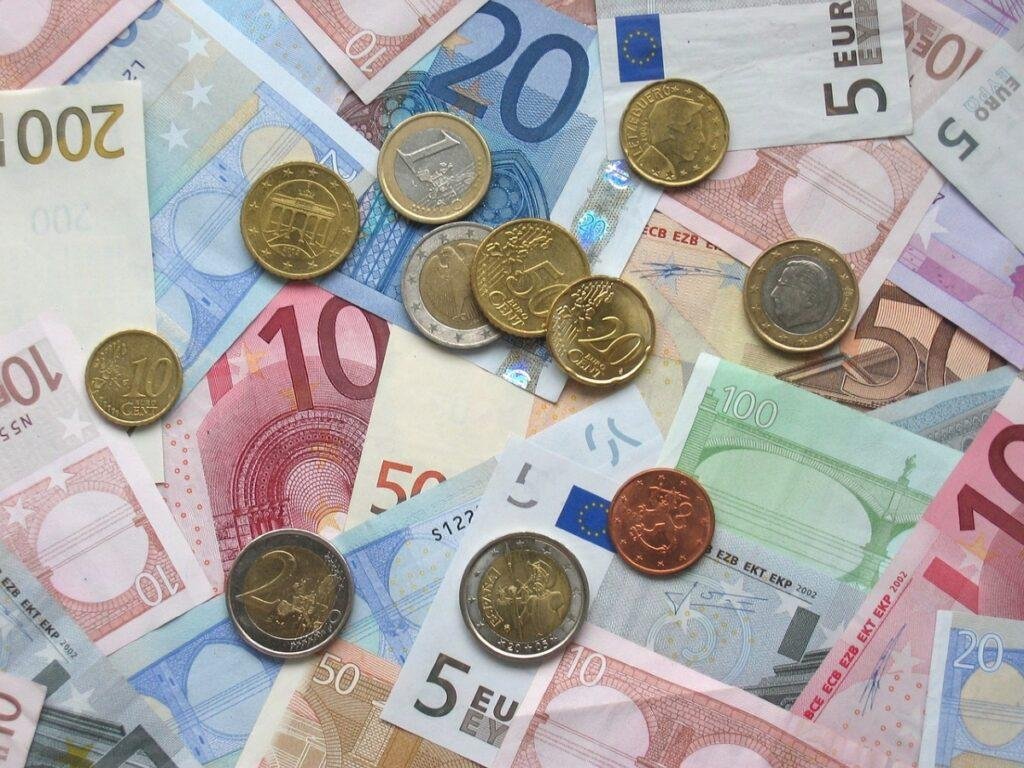
France is part of the European Union; therefore, the currency used here is the Euro.
In my post Currency exchange, cards and cash abroad (Complete Guide), there is a table that allows you to see the currency used by entering the name of the country you are interested in. Additionally, this article provides all the essential information you need to know about money and travelling.
Plugs and Voltage

In France, the plugs are European-style, with types C and F. The voltage is 220-240 volts, and the frequency is 50 Hz.
Remember that you can refer to my article Plug Types by Country to find out about the different types of plugs used in each country and the corresponding voltage. This will help you determine if you need an adapter and the specific type required. You can find this information in the Travel Logistics section, along with everything else you might need to ensure your trip goes smoothly.
When to Go and for How Long

*️⃣ Paris has a continental climate, so summers are hot, and winters are cold with frequent rain.
Therefore, the best time to visit the city is from April to mid-June and from September to October, thus avoiding the cold winter months and the crowds of the sweltering summer months.
If these dates don’t work for you, and you would instead pick a different travel destination based on the most suitable time to visit, I recommend checking out my posts Best Time to Go and Where to Travel Each Month. It will help you plan your trip better.

*️⃣ The ideal duration of the stay would be about 4 or 5 days. However, it is possible to see the city’s main attractions in 3 days.
In my posts, How Many Days I Need to Visit Each Country and How Many Days I Need to Visit Each City, I explain the number of days needed to visit each country and the most tourist cities.
C. Paris – Cultural Information
Flag and Coat of Arms

The flag of Paris is split vertically into two equal parts, one-half blue and the other red. The city’s coat of arms is in the flag’s centre.
The current version of the coat of arms, in use since 1853, features a silver sailboat on the sea waves set against a red background. On top of this, the royal emblem of the golden fleur-de-lis is displayed on a blue background.
However, the flag you’ll see everywhere is the French flag.
Origin
The city’s origins date back to around 259 BC, when a Celtic tribe of fishermen called the ‘Parisii’ settled on the banks of the Seine River. This settlement was established on the Île de la Cité, where the Notre-Dame Cathedral stands today.
In 52 BC, the Romans conquered them and founded a Gallo-Roman city called Lutetia, which means ‘clayey place’.
Clovis I proclaimed it the capital of France in 508 and named it Paris.
Paris is famously referred to as The City of Light. This nickname has its roots in the 17th century (1667), when gas lamps were used to illuminate the streets, marking the world’s first instance of public lighting. However, the primary motive behind this innovation was to reduce street crime, not for aesthetic purposes.

D. Paris in 3–4 Days: Itinerary + Map
Below is the map to visit Paris in 3–4 days. Each day is shown in a different colour, and the numbers indicate the order of the places to visit.
🛏️ Accommodation: Find hotels and unique stays at great prices in Paris with Booking.com.
Paris — Day 1

0 — Free Tour

For your first day in a new city like Paris, I recommend starting with a free tour in the early morning because it provides an excellent overview. Additionally, local guides often share exciting details about the city that may not be found in travel guides.
You will walk around many of the city’s main attractions in a couple of hours. My itinerary includes them, so you can mark them as ‘seen’ if you wish.
🚶♀️📷 Free Tours: Join a fun and informative free tour to explore top sights with a local guide — book now with Freetour.com.
1 — Louvre Museum

A must-see in Paris, the Louvre is the world’s most visited museum, showing over 35,000 art pieces in over 60,000 m2.
Inaugurated in 1793, it has served as a castle, palace, and Ministry of Economy and Finance.
It has some of the most important pieces in the history of art, such as the Mona Lisa, the Venus de Milo, the Winged Victory of Samothrace, Liberty Leading the People, the Code of Hammurabi, the Wedding at Cana or the Raft of the Medusa.



The pyramid at its entrance was inaugurated in 1989, coinciding with the second centenary of the French Revolution.

With its vast dimensions and extensive collection, the museum’s galleries could easily take days to explore. However, the museum can be seen within two hours with proper planning.
You can reserve your tickets on the Louvre’s official website.
2 — Musée d’Orsay


Crossing the Seine to the opposite bank is the Orsay railway station, which houses the world’s finest collection of impressionist art. The museum was inaugurated in 1986.
I understand that impressionism may not appeal to everyone, but you must see it if you’re a fan like me. Here, you will find some of the most famous works, such as Luncheon on the Grass by Édouard Manet, the Painter’s Studio by Gustave Courbet, Self-Portrait by Vincent van Gogh and Bal du Moulin de la Galette by Renoir.
You can check prices and schedules on the museum’s website.
3 — Tuileries Garden


In front of the Musée d’Orsay, on the other side of the river, we will see the Tuileries Gardens. It’s the perfect spot to take a break with their fountains, lakes, and sculptures.
Commissioned by Catherine de’ Medici in 1564 as the garden of the Tuileries Palace, it was redesigned in 1664 by André Le Nôtre, the creator of the gardens of Versailles.
It would be after the French Revolution when they became the first public park in Paris.
They have been part of the UNESCO World Heritage List and the so-called “Banks of the Seine in Paris” since 1991.
4 — Place Vendôme
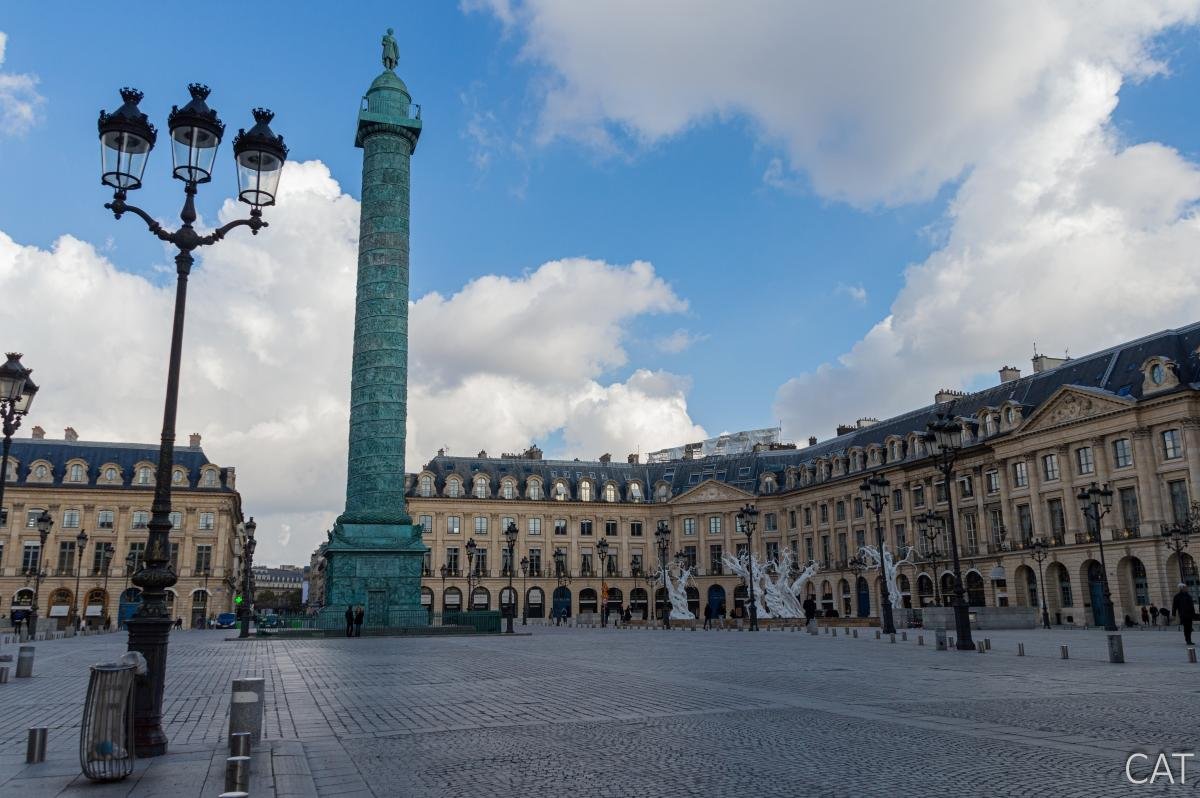
If we turn right in the middle of the Tuileries Gardens and take Rue de Castiglione, about 300 m away, we will find Place Vendôme.
Here is the Vendôme Column featuring a statue of Napoleon I dressed as a Roman general on top. Napoleon III commissioned this statue in 1810 to replace the equestrian figure of Louis XIV, which was destroyed in 1792.
Nowadays, it is one of the epicentres of luxury in Paris, where the leading international jewellery brands come together.
5 — Church of Sainte-Marie-Madeleine (La Madeleine)

Walking toward the northwest, about 8 minutes away, we find this unusual neoclassical-style church: La Madeleine. It took almost 80 years to build (1763-1842) due to political instability, which caused the project to change several times.
On the outside, the imposing building is surrounded by 52 Corinthian columns, simulating a Greek temple. At the same time, its interior hides a single nave with three domes, not visible from the outside.
Napoleon, who ordered its construction, is represented in the apse fresco — something very unusual.
It is one of the most visited churches in the city due to its monumentality. In addition, numerous musical concerts are held here.
Open daily from 9:30 a.m. to 7 p.m.
6 — Place de la Concorde

Continuing south along Rue Royale, we arrive at the Place de la Concorde, the second-largest square in France with about 7.6 hectares.
It was built between 1757 and 1779 under the reign of Louis XV, and its name has been changed several times since then.
During the French Revolution, over 1,200 people, including Louis XVI, Marie Antoinette and Robespierre, were executed by a guillotine installed here.

Since 1836, a 23-metre-high obelisk weighing 222 tons from Luxor has stood in the centre of the square. It is 3,300 years old and was a gift from the viceroy of Egypt, Mehmet Ali.
Two fountains, ‘Fontaine des Mers’ and ‘Fontaine des Fleuves’, are located at both ends of the square.

7 — Champs-Élysées Avenue

The longest avenue in Paris, starting from the Place de la Concorde, stretches almost 2 km and reaches the Arc de Triomphe.
Its name comes from Greek mythology, where the Champs-Élysées was the home of the blessed after death. The gardens were initially designed in 1667.
The Champs-Élysées is one of the most renowned avenues in the world, famous for its theatres, cafés, and luxury shops. It is also the central location for parades in the city, including the final stage of the Tour de France.
The area is home to notable buildings such as the Petit Palais and the Grand Palais.
This is where the traditional Christmas markets are held, featuring hundreds of booths, an ice rink, and a giant Big wheel.
8 — Arch of Triumph
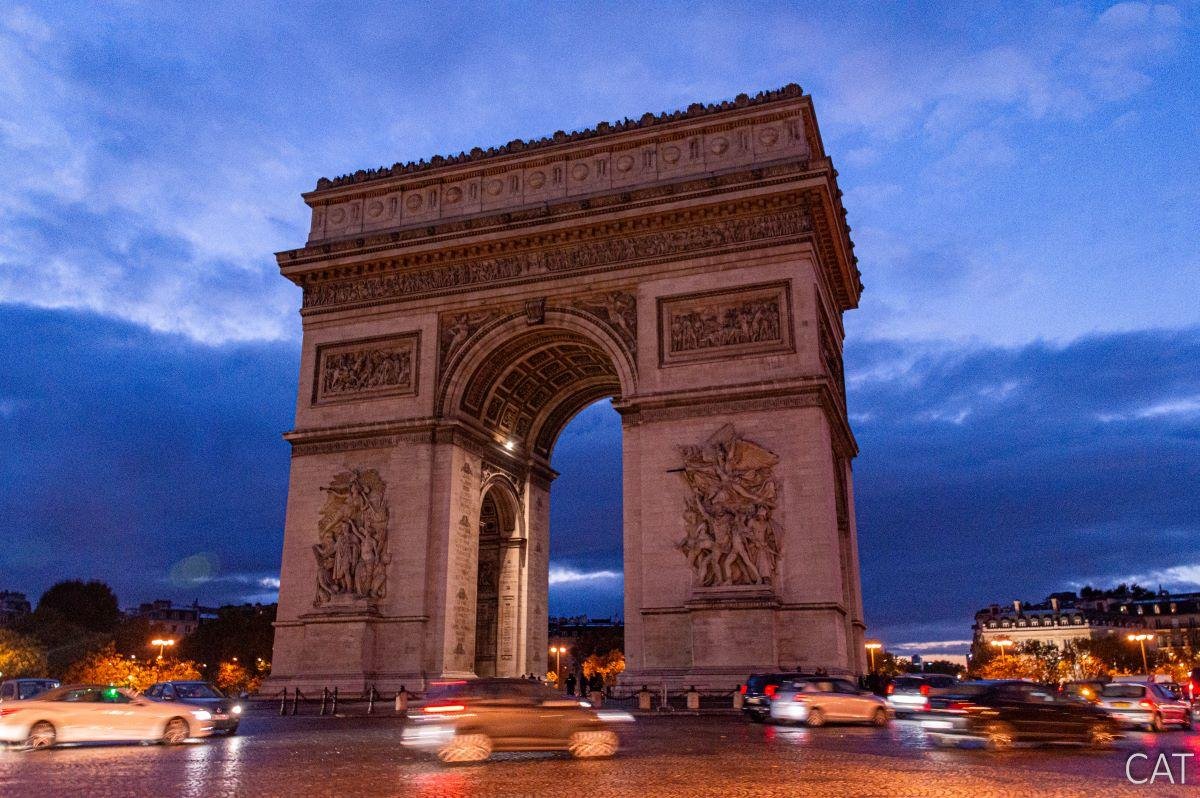
It was built between 1806 and 1836 on Napoleon Bonaparte’s orders, remembering the French army’s victories.
The Arc de Triomphe is 50 metres high and 45 metres wide. The Tomb of the Unknown Soldier, located at the arch’s base, was built in 1921. Each of the monument’s four pillars has an allegorical statue representing triumph, resistance, peace, and the French national anthem, La Marseillaise.
The ticket provides access to the entire monument and its terrace, which can be reached by climbing a 286-step staircase. It remains open until late, allowing you to enjoy the city’s night view from above.
Here is the link to its official website, where you can check schedules and prices as well as reserve your ticket.
⚠ Warning: There are underground steps to reach the arch. Please do not attempt to cross the street.
9 — Trocadéro

Kléber Avenue runs directly from the Arc de Triomphe to Place du Trocadéro and its adjacent gardens.
The name “Trocadero” comes from a battle that took place on the island of the same name in southern Spain. During the battle, the French army defeated the liberal forces that had taken control of the Spanish government and restored the power of the absolutist monarch, Ferdinand VII.
The set is composed of:
- Place du Trocadéro. In the centre stands an equestrian statue of Marshal Foch, who led the Allied armies at the end of World War I.

- Trocadéro Gardens. With a total area of nearly 94,000 square metres, these public spaces are adorned with statues, fountains, and ponds.
- The Chaillot Palace. It offers a breathtaking panoramic view of the Eiffel Tower from its terrace.

10 — Seine River Cruise

Why not end the day with a cruise on the Seine River? It’s the third-longest river in France, at about 777 km.
You will travel through this famous river and see many of the city’s emblematic places and the 37 bridges that cross it.
Many companies provide cruises that last from one to two hours. Here’s a great option for you: GetYourGuide.
You can also enjoy one of these cruises with the Paris Pass.
Paris — Day 2

1 — Notre Dame Cathedral

Following the fire on 04/15/2019, in which 2/3 of the roof was destroyed, it remained closed to the public for 5 years. It was reopened on December 8, 2024.
Note: The photos shown here were taken prior to the restoration.
Notre Dame Cathedral is located on the Île de la Cité, on the banks of the Seine River, and is dedicated to the Virgin Mary.
Built between 1163 and 1345, Notre Dame is a Gothic cathedral, one of the most famous in the world and the most visited monument in Europe (at least until 2019).
Highlights:
- The portico represents the day of final judgment.

- The rose window of the transept.

- The carpentry work of the choir.

- The Towers. You reach the top after climbing 387 steps, but the view from the top makes it worth the effort. Up there, you will see:
- The famous gargoyles. Curiously, these were added in the 19th century.

- A 360° view of the city.

- Emmanuel. It’s the cathedral’s largest and most emblematic bell, weighing almost 13 tons. It is the only one of the ten bells that wasn’t destroyed during the French Revolution.

Entry to the cathedral was free, and you only had to pay to climb the towers. We’ll see what happens once it’s reopened.
It has been part of the UNESCO World Heritage List and the “Banks of the Seine in Paris” since 1991.
Since 1924, a plaque outside the cathedral with an 8-pointed star has marked Point Zero. It is the starting point for measuring distances between Paris and other French cities.
2 — Place Louis Lépine

After a short walk of less than 5 minutes to the west, you will arrive at Place Louis Lépine.
This square is home to a famous flower market, created by order of Napoleon in January 1808. It becomes a large market for live birds and other pets on Sundays.
The only metro stop on the island, Cité, is in the square.
3 — Sainte-Chapelle

Standing next to Place Louis Lépine is the Sainte-Chapelle, a Gothic-style church built between 1242 and 1248 to house the relics of the Passion of Christ. It showcases stunning stained-glass windows.
The relics—the Crown of Thorns and a piece of the Holy Cross—were bought by Louis IX from the emperors of Constantinople. They are currently held in the Treasury of Notre Dame Cathedral.
4 — La Conciergerie

On the opposite side of the Palace of Justice lies the Conciergerie. It served as a royal palace until the 14th century before being transformed into one of the harshest prisons in 1392.
Marie Antoinette and Robespierre were among the prisoners.
In the corner of the building, specifically the intersection between Boulevard du Palais and Quai de l’Horloge, you’ll find France’s first public clock from 1370. Henry de Vick designed this clock under the orders of Charles V.

5 — Pont Neuf

Located at the western end of Île de la Cité, the Pont Neuf, which means “New Bridge”, is the city’s oldest bridge.
This building was constructed in 1578 during the reign of Henry IV. It was the first stone building in the city and was revolutionary for its time, featuring sidewalks and no homes. Additionally, it was the widest in the city at that time.
In the centre of the bridge stands an equestrian statue of Henry IV.

6 — Latin Quarter

Crossing the Pont Neuf and walking south for about 14 minutes will take us to the Latin Quarter.
It was named after the Latin language, commonly spoken in the area by students who lived nearby due to its proximity to the university.
In this neighbourhood, many bars and cafés offer affordable prices.
Do not miss:
a) Luxembourg Gardens


Marie de’ Medici commissioned the gardens in 1612. Currently, the Luxembourg Gardens also serve as the garden of the French Senate, whose headquarters are located in the Luxembourg Palace.
It comprises 25 hectares, 3,000 trees, 5,000 m² of flowers, 102 statues, and monuments, including the famous Medici fountain.
Parisians nicknamed the garden Luco, an abbreviation of Lucotitius, the Roman name of the mountain on which the garden is situated.
Its opening times adapt to sunrise and sunset every two weeks, and closing times can vary significantly depending on the time of year.
b) Pantheon

Less than 10 minutes walking to the east, we find the Pantheon.
Built between 1764 and 1790 in a neoclassical style on the outside, inspired by the one in Rome, it stands out as one of the most recognisable buildings in the Parisian landscape.
Originally built as a church to honour Saint Genevieve, the building was later converted into a mausoleum to honour important figures in French history after the French Revolution.
Upon entering, visitors can observe a replica of Foucault’s pendulum, which he constructed in the Pantheon to demonstrate the Earth’s rotation on its axis. The original pendulum is now housed in the National Conservatory of Arts and Crafts.

In its crypt are the remains of famous people such as Victor Hugo, Voltaire, Rousseau, Marie Curie, Braille, Alexandre Dumas and Jean Monnet.




At the top, there’s a viewpoint where you can climb to admire the city’s beauty.
It is open daily from 10 to 18 hours (18:30 in summer). You can reserve your ticket on its official website.
c) Sorbonne University

It’s worth noting that Sorbonne University, which originated in 1253, is just a 10-minute walk northwest in the same neighbourhood.
Its church contains Richelieu’s tomb.
7 — Place de la Bastille

Our next stop will be the symbolic Place de la Bastille, known for the infamous Bastille prison, which has almost entirely disappeared.
The Bastille was constructed as a fortress during the Hundred Years’ War to protect the gateways to Paris. Later, it was repurposed as a state prison.

In 1789, the Bastille prison became famous after the people of Paris stormed it on July 14 to free political prisoners, marking the beginning of the French Revolution. Shortly afterwards, the prison was destroyed, and a guillotine was installed.
In the centre of the square stands the July Column, commemorating the 1830 revolution that established France’s first constitutional monarchy.
It was built in 1840 and serves as the burial site for the remains of 504 uprising victims.
At the top, you can see a gilded bronze sculpture called the “Genius of Freedom.”
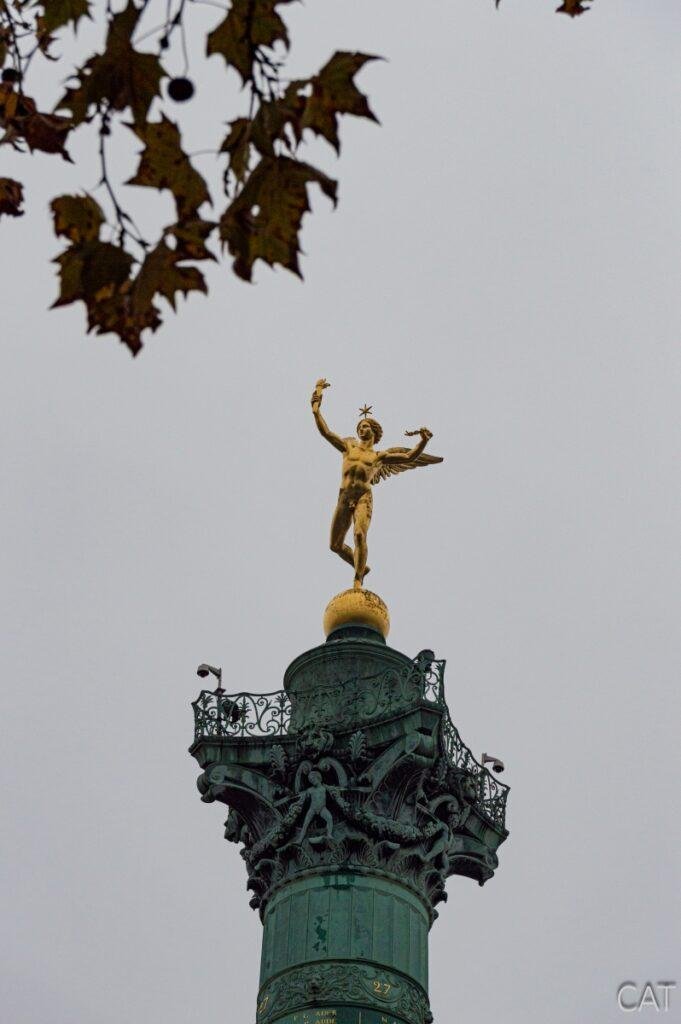
8 — Père Lachaise Cemetery

After a 25-minute walk or a 10-minute ride on public transport to the northeast, we will arrive at the Père Lachaise Cemetery—the world’s most famous and visited cemetery and the largest in Paris.
Many famous people, such as Jim Morrison, Oscar Wilde, Marcel Marceau, and Frédéric Chopin, are buried in this place, also used as a park by Parisians.



Here’s the link to the cemetery map, which includes a list of the most famous tombs.
Paris — Day 3

1 — Eiffel Tower

The Eiffel Tower is undoubtedly the signature landmark of the city and one of the most recognised symbols internationally.
Despite many detractors, the Eiffel Tower was built in 1889 for the Universal Exhibition. However, it was only intended to be maintained temporarily.
With a height of 312 metres (excluding the antenna), it was the tallest building in the world until 1930. Currently, it stands at 330 metres.
There are five elevators to the second floor and two duo lifts to the top. It has 1665 steps, but you can only walk up to the second floor, which has 674 steps.
The Eiffel Tower lights up in golden colours as night falls, and its lighthouse rotates to illuminate Paris. Additionally, it flashes for 5 minutes at the beginning of each hour, creating a stunning display.

I suggest visiting the place early in the morning or late in the evening to avoid crowds.
You can buy your ticket directly on the Eiffel Tower’s official website, but tickets sell out quickly because it offers cheaper prices.
You can go up to the second floor or the top. However, booking your tickets in advance is highly recommended, as there is always a high demand. Remember that this is one of the most frequently visited monuments in the world.
Views from the Tower
Once at the top, don’t miss:
- Trocadéro. Impressive views of the entire complex: the square, the gardens and the Chaillot palace.

- Île aux Cygnes (Swan Island). There is an artificial island that was created in 1827. It is 850 metres long and 11 metres wide at its broadest point. On this island, there is a replica of the Statue of Liberty, which the United States gifted to France during the celebration of the centenary of the French Revolution. This statue is four times smaller than the original and faces New York.

- La Défense. One of Europe’s most important financial districts. You can’t miss it because it is a group of towers and skyscrapers located west of Paris.

2 — Champ de Mars

The Champ de Mars park stretches over 24.3 hectares opposite the Eiffel Tower.
Its name honours the Roman god of war, Mars, since the Military School used it as a manoeuvre field at the opposite end of the Eiffel Tower.
Since 1991, it’s been part of the UNESCO World Heritage List and the “Banks of the Seine in Paris.”
3 — Les Invalides

Close to the Champ de Mars is another of Paris’s most significant monuments: Les Invalides.
Although not known for its artistic value, the site is the final resting place of some of France’s most famous military leaders, including Napoleon Bonaparte’s tomb.

Les Invalides is a complex of buildings that includes museums and monuments related to the military history of France.
It comprises a hospital, a retirement home, the national cathedral of the French army, a former hospital chapel, and the adjacent ‘Dôme des Invalides,’ the highest church in Paris.
4 — Pont Alexandre III

We will cross the Seine to the north using the beautiful Alexandre III Bridge, inaugurated for the Universal Exposition of 1900 and one of Paris’s longest and most ornate bridges.
The bridge is dedicated to Tsar Alexander III. His son, Tsar Nicholas II of Russia, laid the first stone in 1896 to celebrate the Franco-Russian alliance achieved by his father.

Several famous movies have been filmed here, such as Midnight in Paris, A View to a Kill, Ronin, Sabrina, and Anastasia.
In addition, it is part of the ‘Banks of the Seine of Paris’ delimitation, which UNESCO declared a World Heritage Site in 1991.
5 — Montmartre Neighbourhood

Our next destination is Montmartre, a charming and bohemian neighbourhood of the city famously known as the Painters’ Quarter.
It is situated at the top of a 130-metre-high hill, and to get to its upper part, you can either climb its 197 steps or take the cable car.
Montmartre was an independent district until 1860. It gained a bad reputation for brothels and cabarets, but that would change with the arrival of numerous artists, including Monet, Renoir, Degas, Toulouse-Lautrec, Van Gogh, and Picasso.
It’s best to take public transport to Pigalle or Blanche from the Alexandre III Bridge, as it’s about a 45-minute walk.
Things you shouldn’t miss in this neighbourhood:
5.1 — Plaza Pigalle

It stands out for its neon lights, sex shops, and adult shows. During World War II, its reputation as a ‘sleazy neighbourhood’ led to its nickname, “Pig Alley.”
Some theatres, including the famous Moulin Rouge, remain here.
5.2 — Moulin Rouge

Located on Boulevard de Clichy, the Moulin Rouge is possibly the world’s most famous cabaret. It was founded in 1889 and rebuilt in 1925 after a fire.
The Moulin Rouge has won six world records, including the most leg lifts.
If you want to see one of their popular shows, visit their official webpage to reserve your tickets.
5.3 — Café des Deux Moulins

While walking up Rue Lepic, you will come across the famous Café des Deux Moulins. This café gained international recognition due to its appearance in the 2001 film Amélie, where Amélie worked as a waitress.
5.4 — Montmartre Cemetery

The Montmartre Cemetery, officially the Northern Cemetery, was inaugurated in 1825. With 11 hectares of area, it is Paris’s second most popular necropolis.
It is home to famous tombs, including those of Stendhal, Zola, Dalida, Alexandre Dumas, Edgar Degas, and Offenbach.
Here is the map of the cemetery and its most famous tombs.
5.5 — The “I Love You” Wall

Walking along Rue de Abbesses, located next to its Metro stop, you will see an attraction known as ‘the wall of love‘.
This attraction is a 40-metre-long mural of 612 lava tiles created by Frédéric Baron and Claire Kito. It is a tribute to love and features the phrase “I love you” in over 300 languages and dialects.
5.6 — Sacré-Cœur Basilica

Located on the highest point of Montmartre, which has been a worship site since the Iron Age, the Basilica of the Sacred Heart (Sacré-Cour) stands tall.
This magnificent temple was constructed between 1875 and 1914 and officially opened in 1919 as a tribute to the soldiers who lost their lives after the Franco-Prussian War. The architect behind its design, Paul Abadie, drew inspiration from the Hagia Sophia in Istanbul, which is evident in the temple’s neo-Byzantine style.
The central tower is 83 metres tall, and you can climb to the dome. The views from the top are good, but if you have already climbed the Eiffel Tower, they might not be as impressive. Additionally, the tower houses the largest bell in France, ‘La Savoyarde,‘ which weighs 26 tons.
Inside the apse is the largest mosaic in France (473 m³), representing the heart of Jesus. It also has a crypt that I do not think is worth the entrance fee.

Outside, there is a panoramic terrace with fantastic views of Paris.
It opens daily from 6:30 a.m. to 10:30 p.m., and admission is free. You only pay if you want to see the crypt and climb the dome.
5.7 — Plaza du Tertre

About 4 minutes to the west, we find this small, charming square popular among painters.
The square is called Place du Tertre due to its location on the Montmartre hill (Tertre means “little hill”).
The first Parisian bistro, La Mère Catherine, was established in this square in 1814. The name “bistro” originated from the Russian soldiers who used to shout “bistro” (meaning fast) while ordering their drinks during the occupation of Paris. Over time, the name stuck, and nowadays, a bistro is a small French-style restaurant that is quite popular and serves high-quality meals.
6 — Montparnasse Tower

And what better way to end the day than watching the sunset from one of the best places in Paris: Montparnasse Tower.
Built between 1969 and 1972, it is 210 meters long and has one of the fastest elevators in Europe.
There is a café on the 56th floor with fantastic views and a spectacular terrace on the 59th floor, offering 360° views.
You will see the city’s most important landmarks, including a stunning view of the Eiffel Tower.
Until here, the 3-day route through Paris.
TIP: Most museums offer free entrance on the first Sunday of every month, so take advantage of this opportunity!
For those with additional days in this beautiful city, below are some other interesting places to visit.
Clarification
Before moving forward, I want to address a common question that many people may have: Why have I excluded the Palace of Versailles from the 3-day itinerary, despite being one of the most popular attractions in Paris and a World Heritage Site since 1979?
Allow me to explain my reasoning:
- Distance. The palace is located in Versailles, approximately 20 km from the city centre of Paris. However, travelling to and from the palace can take 1.5 to 2 hours.
- The total duration required for the visit. It takes at least 3 hours to see the most important things, going quickly and selecting a lot of what to see. Remember that this is not a palace; it is a set of buildings and gardens that cover 800 hectares and have about 500 rooms that can be seen, so do the maths!
- I’m not a big fan of palaces.
Visiting Versailles takes almost an entire day. If I had only three days in Paris, I would prioritise seeing all the attractions on my three-day itinerary rather than sacrificing one of those days for Versailles. Therefore, I would leave the visit to Versailles on a fourth day in the city.
Additional Days

1 — Palace of Versailles

As mentioned above, it is one of the most popular tourist attractions in the world and has been listed as a World Heritage Site by UNESCO since 1979.
This former royal residence—the Palace of Versailles—was built by King Louis XIV (the Sun King), who established the court and government of France here in 1682.
Given the venue’s enormous dimensions, seeing everything is complicated, so you must prioritise.
Some things you shouldn’t miss are:
- Hall of Mirrors
- Great Chambers of the King and Queen
- The Opera
- Great Chapel
- The ‘Great Trianon’ and the ‘Little Trianon’
The gardens stand out, particularly the ponds and fountains around the main building and the Fountain of Apollo.
Here is the link to its interactive map.
2 — Catacombs

They have more than 300 km of tunnels, although only 1.5 km are open to the public. Its ossuary has the highest concentration of human skeletons in Europe (6 million).
3 — Montparnasse Cemetery
It opened its doors in 1824, covers an area of 19 hectares, and was initially known as Southern Cemetery.
This cemetery is famous because the remains of many famous people rest there. Some of them are: Charles Baudelaire, Jean-Paul Sartre, Simone de Beauvoir and Julio Cortázar.
4 — Musée Rodin

Next to Les Invalides, you can find the Rodin Museum. It was inaugurated in 1919 and exhibits the works of the renowned sculptor Auguste Rodin.
The museum also features a beautiful garden spanning over 3 hectares, exhibiting some of the most famous works, including The Gate of Hell and The Thinker.
5 — Saint-Germain Neighbourhood
It is one of the most elegant neighbourhoods in the city, with numerous luxury boutiques, art galleries and iconic cafés such as Café de Flore and Deux Magots, which became famous for being frequented by intellectuals in past decades.
6 — Palais Garnier (Opera)

The Paris National Opera is one of the oldest in Europe. Napoleon II ordered the construction of this imposing neo-baroque building and inaugurated it in 1875.
With 172 meters long and 124 meters wide, the Opera Garnier is one of the largest in Europe, with a capacity of 2,000 seats.
7 — Centre Pompidou

Modern art lovers should consider visiting the Center Pompidou, although it may be for some people’s taste.
It was opened to the public in 1977 and is home to the Museum of Modern and Contemporary Art. The museum has an extensive collection of about 100,000 works of art, making it one of the most comprehensive collections in the world. The exhibition includes works by world-famous artists such as Kandinsky, Picasso, Duchamp, Andy Warhol, and Matisse.
Extra Days: Disneyland Paris
For those who are fans of theme parks (I am not, but I still had to mention it), Disneyland Paris can be an option if you have a few extra days to spare and are unsure of what else to do in the city. However, given the many attractions and activities available in Paris, it’s doubtful that you would run out of things to do.
The park was inaugurated in 1992 and covers an area of 700 hectares.
I hope you enjoyed this itinerary.
E. Ready to Book your Trip?
To help you organise your adventure, I’ve gathered the best tools I use and recommend for booking flights, hotels, local transport and more. These links support this site at no extra cost to you.
🧳 Book Your Trip Here
- ✈️ Flights: Compare the best prices on flights using Kayak.
- 🛏️ Accommodation: Find hotels and unique stays at great prices worldwide with Booking.com.
- 🚐 Transfers: Pre-book your airport or city transfers to avoid stress on arrival with Welcome Pickups.
- 🚗 Car Rentals: Explore destinations at your own pace by using Discover Cars or Auto Europe to compare reliable car rental providers.
- 💺Transport (Bus and Train Tickets): Compare schedules and easily book intercity bus and train travel with Omio.
- 📷 Tours & Activities: Book fun experiences, guided tours, and skip-the-line tickets in advance with GetYourGuide or Viator.
- 🌐 Internet Connection: Stay connected abroad with eSIMS from Airalo.
Safe travels! 🌏✈️
Additional Information
You can also check my itineraries in Itineraries. Here, you’ll find them classified in City Guides and Country Guides.
Alternatively, in the section Destinations, they are classified based on the type of trip:
📌 If you prefer to see them separated by continents, check them in Portfolios.
Remember to check the Cook up Your Trip. There, you will find everything you need to organise your trip from start to finish.
If you need any clarification, you can leave me a comment or fill out the contact form. I will be happy to help you. 😊

